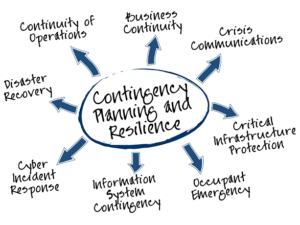Don’t be in denial
If you are unfortunate enough to have to deal with a disaster, you will be much better placed if you have given your worst case scenario some consideration prior to the disaster taking place.
The statistics tell it all. 75% of small businesses have no business continuity plan objective in place.
While it is impossible to plan for every possible scenario that may or may not eventuate, not having anything in place in regard to how you may be able to operate your business in the event of the unforeseen happening does not have to be the case.
The vast majority of businesses who come to us for assistance simply do not do anything about planning for business continuity because they do not know where to start. Once they undergo the journey of putting a plan in place, they cannot believe how easy it was to do.
Continuity or Disaster
Wikipedia’s definition of Business Continuity Planning is the goal to enable ongoing operations before and during execution of disaster recovery. Disaster recovery is therefore a part of business continuity. Having a plan in place will allow you to effectively deal with anything from a disruption right through to a disaster.
Where do I start
Business Victoria provide a template to get you started. They also provide some great information on what to do when things do not go to plan. CPA Australia also have a toolkit to assist.
As IT runs the majority of business processes in the modern world, IT Networks can ensure that your technology fits in with your business continuity plan. Business Continuity is not a technology issue, it is a business issue. Someone who understands both business and technology is required to assist you with mitigating the risks in developing an appropriate continuity plan. This is the role typically given to a CIO to address.
How expensive is it?
The cost of putting together a Business Continuity Plan is going to vary based on the size of the organisation. As a general rule of thumb, the cost of putting together your Business Plan should be very similar to the cost of putting together a Business Continuity Plan. Both documents are mandatory for any business to not just grow, but to effectively stay in business.
Things to consider
Anything that can adversely impact your business operations needs to be be identified. Some of the commonly identified items to consider are listed below:
- Supply chain disruption
- Loss or damage to critical infrastructure
- Availability of human resources
- Access to documents (physical or electronic)
Once identified, the impact of each item needs to be reviewed and a business impact analysis performed so the associated risk can be mitigated.
Who needs to be involved
As with any other type of plan that will impact on the business, the key staff and stakeholders need to be involved with developing the plan. Third parties that are identified during planning typically become involved where required.
Finally
The ultimate result for any plan that addresses business continuity is the return to normal operations. What was done to keep your business operations running during a disaster or even a disruption may significantly impact on you returning back to normal operations. A well laid out plan will identify what is required and the quickest, cheapest and easiest way to return to normal.
If you require any assistance, we are here to help. We are able to point you in the right direction, put something in place for you or review what you may already have in place.



